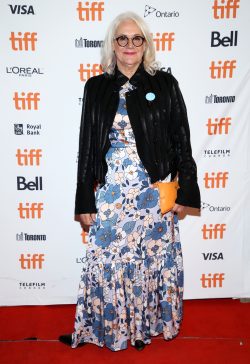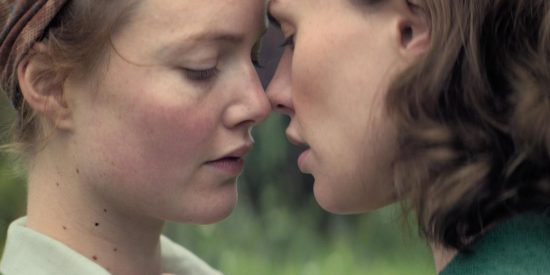TIFF 2018: In Conversation with Director Annabel Jankel of Tell it To the Bees

TORONTO, ON – SEPTEMBER 09: Annabel Jankel attends the “Tell It To The Bees” premiere during 2018 Toronto International Film Festival at Winter Garden Theatre on September 9, 2018 in Toronto, Canada. (Photo by Phillip Faraone/Getty Images,)
I had the privilege of meeting director Annabel Jankel just hours before the world premiere of her film, Tell it to The Bees, was to screen at the Toronto International Film Festival. The Wintergarden theatre, a whimsical venue with greenery and patio lanterns hanging from the ceiling, seemed the perfect place to bring a movie, which centres so much on nature and, yes, bees to its first audience. And while Annabel outwardly seemed calm and measured, she admitted, “I’m in terror… Mixed in with complete excitement, and just really eager to see what the reaction is.”
Jankel has had a decades long career as, not only a director but also a writer, animator, producer in TV and film. Her newest project is her first directed feature film since 1993. Based on the novel by Fiona Shaw, Tell it to the Bees is the story of two women who find, and in a way rescue, each other in small town Scotland as told through the eyes of a young boy, Charlie. Starring Anna Paquin, Holliday Grainger and Gregor Selkirk the film is truly a love story, in many different forms. This being her first film at TIFF, we had a chat about the making of the movie, as well as her thoughts on what women bring to the table in the industry.
Hillary Butler, Live for Films (LFF): Tell me, what attracted you to the novel?
Annabel Jankel (AJ): As soon as I started reading it, I was fully engaged, and that’s something that doesn’t happen that often. I became really intrigued by the characters. I really love the triangle. I love the fact that there was a boy, an innocent boy, that was going to go through a coming of age. And then when I thought more about it, I realized that the two women that were inevitably drawn to each other, they also had a coming of age, in their own individual ways. I found it had all the ingredients for what I really wanted to do, which was a love story.
LFF: While you were reading the novel did you picture any specific actors in the roles?
AJ: You know, I never do because I really think more conceptually and visually. So, for me, it is an entirely movable feat because you know that the minute that you cast one actor specifically in that image, you are hardwiring that into your brain. It may not be that that could be the case, so there’s no real point to that unless I was writing something specifically for a specific actor. I keep an open mind, actually. It’s very difficult with kids of course. You wouldn’t really visualize kids because they change every three months, basically. But of course, I am completely thrilled with both having Anna Paquin and Holliday Grainger.
LFF: Did the author of the novel [Fiona Shaw] have any influence or was she involved in the filmmaking process at all?
AJ: She was very available to us, which was fantastic. When I first sat down with her to discuss the possible adaptation and to see whether she was on board with it, we talked through a lot of the ideas that she had had and why she has written it. I wanted her very much to be involved, and she was very supportive, and we did go through quite a few various changes and adaptations. Of course, what happens to the characters in the end is different to what happens to the characters at the end of the book, and she was well on board with that.
LFF: Did it just work better cinematically to change the ending?
AJ: It worked better in the context of it being a story being told about the 50s, and I didn’t want to come at it with a contemporary take on the 50s. We’ve gone through some radical changes in the intervening 70-odd years but it felt as though for the film language it needed to have the scope to breathe outside of the end of the story. I’m hoping that’s what people will take away from it, is that the debate continues, the conversation continues, about why the characters ultimately had to make those choices.
LFF: Were there specific challenges you faced making a period drama?
AJ: Huge challenges, especially with limited budget. I had to find a street, and I had to find a location in Scotland that was very true to the 50s. Of course, you have to go through inevitable things like taking out all the road signage and all the normal stuff, bus stops and those things, but this was a street that was just pretty immaculate, and then we pretty much kept to just two main locations, that area and the house where the doctor lives…
I really wanted to find somewhere that was hive-like, and this particular one street in Scotland, in Stirlingshire, had that quality of it being a microcosm-like enclosure. The characters could not really escape. They faced a lot of challenges within this hive-like community, and all those obstacles were going to be the reasons why, ultimately, they could go their own way.
LFF: The old adage is never work with children or animals and you broke both those rules…
AJ: Six thousand wild animals.
LFF: What was it like working with all those bees?
AJ: It was really tricky because when we shot it was really pretty much the end of the summer, and the bees are getting sleepy at that time of the year. We had to keep making sure that we got as much action out of them as possible. We had a bee cinematographer, and we had this bee whisperer that came with him. The bee whisperer would wrangle the bees, and slept with the bees, and looked after the bees, and made sure the bees knew that it was him. Just like any apiarist, the bees know who the beekeeper is.
LFF: You’re telling a story of women in love, but also a woman who is a doctor, which at that time, would have been pretty much unheard of. How important do you think it was to have a woman tell that story, both from a writing perspective and a directing perspective?
AJ: I wonder if that story would ever be told by a male author. That’s very possibly unlikely. It was Fiona Shaw’s novel. It was her original story, and I think the fact that I, as a woman, felt drawn to it, adds fuel to the idea that it’s a female-driven story. I don’t think it would have happened with any other gender.
LFF: In your career within this industry, which has spanned decades, how have things changes or how are you seeing them develop?
AJ: Things are changing. I think that’s really interesting, actually, because I think particularly that’s what this film is about at its core, change. About change coming to a town. Change coming to these two women that ultimately are to be comfortable with who they are, and what their potential is. I think that the fact that there’s such a lot of conversation now going on about why women have been sidelined for so long, and all these stories that women want to tell, and women want to see, and the fact we all want to see… It’s been slow process, but I think now it’s come into the mainstream, and this is something that we all need to pay attention to.










